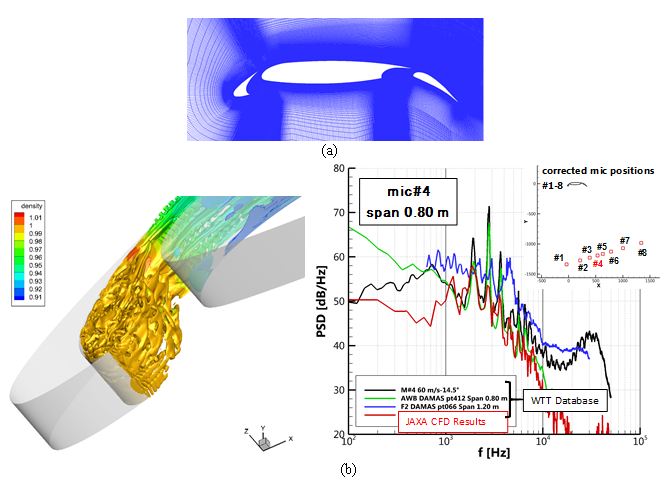Research on Airframe Noise Reduction Design in the FQUROH Project
JAXA Supercomputer System Annual Report April 2016-March 2017
Report Number: R16E0028
- Responsible Representative: Kazuomi Yamamoto(FQUROH Project Team (Flight Demonstration of Quiet Technology to Reduce Noise from High-Lift Configurations Project Team), Aeronautical Technology Directorate)
- Contact Information: Yasushi Ito(ito.yasushi@jaxa.jp)
- Members: Kazuomi Yamamoto, Yasushi Ito, Takehisa Takaishi, Mitsuhiro Murayama, Ryotaro Sakai, Tohru Hirai, Kentaro Tanaka, Kazuhisa Amemiya, Gen Nakano, Takashi Ishida
- Subject Category: Aviation(Aircraft,Body sound)
Abstract
This research is being carried out as part of the FQUROH project aimed at raising the technical maturity level of the noise reduction technology for high-lift devices and landing gear, which draws international attention to reduce noise in areas around airports, to a level applicable to future development of aircraft and related equipment. This contributes to reduction of aircraft noise in local communities around the airport and airline operating costs by reducing landing fee.
Goal
Objective
References and Links
Use of the Supercomputer
One of the objectives of the FQUROH project is to verify the feasibility of practical noise reduction concepts and design methods based on advanced computational simulations based on large-scale Reynolds-averaged Navier-Stokes (RANS) simulations and more advanced computational simulations, such as Large/Detached Eddy Simulations (LES/DES). The JSS2 was used to understand detailed physics of noise generation, to optimize noise reduction designs.
Necessity of the Supercomputer
The FQUROH project aims to accelerate technology maturity of airframe noise reduction methods using advanced computational simulations on the JSS2’s high performance computing platform and to demonstrate the high-fidelity design technologies through the flight test. Computational simulations using the JSS2 made it possible to design low-noise devices by understanding detailed physical phenomena, which was difficult only with wind tunnel tests.
Achievements of the Year
– Through benchmarking problems using high-lift airfoils for slat noise simulations, a validation study of a CFD unsteady flow problem using a Delayed DES method (Fig. 1), a parametric study of influence of flow parameters (Reynolds number, etc.) on noise prediction, and a validation study of several noise reduction concepts were achieved.
– Detailed flow fields and noise sources around a baseline slat of a target aircraft without low noise devices were clarified. Based on the computational results, an initial geometry with a noise reduction concept applied was designed and evaluated.

Fig.1:Validation study of a CFD unsteady flow problem through a benchmarking problem on slat noise: (a) Computational grid; (b) Example of computational results (Left: Iso-surface of streamwise vorticities colored by density; Right: Evaluation of far-field noise level)
Publications
Non peer-reviewed articles
1) Yamamoto, K., Hayama, K., Kumada, T. and Hayashi, K., ‘FQUROH: A Flight Demonstration Project for Airframe Noise Reduction Technology – Concept and Current Status,’ 22nd AIAA/CEAS Aeroacoustics Conference, Lyon, France, No. AIAA-2016-2709, 2016, DOI: 10.2514/6.2016-2709.
2) Murayama, M., Yokokawa, Y., Ito, Y., Yamamoto, K., Takaishi, T. and Ura, H., ‘Study on Change of Noise Generation by Slat Track Shape,’ 22nd AIAA/CEAS Aeroacoustics Conference, Lyon, France, No. AIAA-2016-2959, 2016, DOI: 10.2514/6.2016-2959.
Presentations
1) R. Sakai, M. Murayama, Y. Ito, K. Yamamoto, M. Terracol, E. Manoha, ‘BANC-IV Category 6: DLR Slat Noise Configuration –JAXA’s Result,’ 4th AIAA Workshop on Benchmark Problems for Airframe Noise Computations (BANC-IV), June 2016, Lyon, France.
Computational Information
- Parallelization Methods: Process Parallelization
- Process Parallelization Methods: MPI
- Thread Parallelization Methods: n/a
- Number of Processes: 1728
- Number of Threads per Process: 1
- Number of Nodes Used: 54
- Elapsed Time per Case (Hours): 80
- Number of Cases: 20
Resources Used
Total Amount of Virtual Cost(Yen): 38,193,766
Breakdown List by Resources
| System Name | Amount of Core Time(core x hours) | Virtual Cost(Yen) |
|---|---|---|
| SORA-MA | 23,464,884.44 | 37,646,066 |
| SORA-PP | 3,596.82 | 30,709 |
| SORA-LM | 0.28 | 6 |
| SORA-TPP | 0.00 | 0 |
| File System Name | Storage assigned(GiB) | Virtual Cost(Yen) |
|---|---|---|
| /home | 79.30 | 500 |
| /data | 16,283.90 | 102,831 |
| /ltmp | 3,301.71 | 20,849 |
| Archiving System Name | Storage used(TiB) | Virtual Cost(Yen) |
|---|---|---|
| J-SPACE | 190.05 | 392,801 |
Note: Virtual Cost=amount of cost, using the unit price list of JAXA Facility Utilization program(2016)
JAXA Supercomputer System Annual Report April 2016-March 2017


